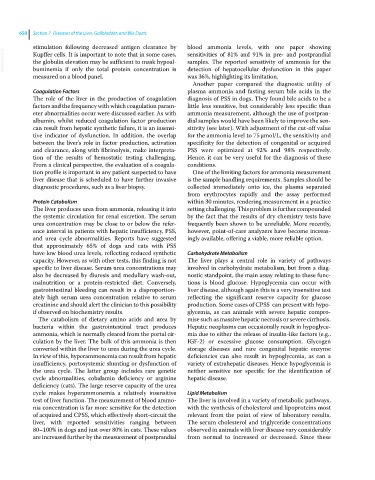Page 682 - Clinical Small Animal Internal Medicine
P. 682
650 Section 7 Diseases of the Liver, Gallbladder, and Bile Ducts
stimulation following decreased antigen clearance by blood ammonia levels, with one paper showing
VetBooks.ir Kupffer cells. It is important to note that in some cases, sensitivities of 81% and 91% in pre‐ and postprandial
samples. The reported sensitivity of ammonia for the
the globulin elevation may be sufficient to mask hypoal-
buminemia if only the total protein concentration is
was 36%, highlighting its limitation.
measured on a blood panel. detection of hepatocellular dysfunction in this paper
Another paper compared the diagnostic utility of
Coagulation Factors plasma ammonia and fasting serum bile acids in the
The role of the liver in the production of coagulation diagnosis of PSS in dogs. They found bile acids to be a
factors and the frequency with which coagulation param- little less sensitive, but considerably less specific than
eter abnormalities occur were discussed earlier. As with ammonia measurement, although the use of postpran-
albumin, whilst reduced coagulation factor production dial samples would have been likely to improve the sen-
can result from hepatic synthetic failure, it is an insensi- sitivity (see later). With adjustment of the cut‐off value
tive indicator of dysfunction. In addition, the overlap for the ammonia level to 75 μmol/L, the sensitivity and
between the liver’s role in factor production, activation specificity for the detection of congenital or acquired
and clearance, along with fibrinolysis, make interpreta- PSS were optimized at 92% and 98% respectively.
tion of the results of hemostatic testing challenging. Hence, it can be very useful for the diagnosis of these
From a clinical perspective, the evaluation of a coagula- conditions.
tion profile is important in any patient suspected to have One of the limiting factors for ammonia measurement
liver disease that is scheduled to have further invasive is the sample handling requirements. Samples should be
diagnostic procedures, such as a liver biopsy. collected immediately onto ice, the plasma separated
from erythrocytes rapidly and the assay performed
Protein Catabolism within 30 minutes, rendering measurement in a practice
The liver produces urea from ammonia, releasing it into setting challenging. This problem is further compounded
the systemic circulation for renal excretion. The serum by the fact that the results of dry chemistry tests have
urea concentration may be close to or below the refer- frequently been shown to be unreliable. More recently,
ence interval in patients with hepatic insufficiency, PSS, however, point‐of‐care analyzers have become increas-
and urea cycle abnormalities. Reports have suggested ingly available, offering a viable, more reliable option.
that approximately 65% of dogs and cats with PSS
have low blood urea levels, reflecting reduced synthetic Carbohydrate Metabolism
capacity. However, as with other tests, this finding is not The liver plays a central role in variety of pathways
specific to liver disease. Serum urea concentrations may involved in carbohydrate metabolism, but from a diag-
also be decreased by diuresis and medullary wash‐out, nostic standpoint, the main assay relating to these func-
malnutrition or a protein‐restricted diet. Conversely, tions is blood glucose. Hypoglycemia can occur with
gastrointestinal bleeding can result in a disproportion- liver disease, although again this is a very insensitive test
ately high serum urea concentration relative to serum reflecting the significant reserve capacity for glucose
creatinine and should alert the clinician to this possibility production. Some cases of CPSS can present with hypo-
if observed on biochemistry results. glycemia, as can animals with severe hepatic compro-
The catabolism of dietary amino acids and urea by mise such as massive hepatic necrosis or severe cirrhosis.
bacteria within the gastrointestinal tract produces Hepatic neoplasms can occasionally result in hypoglyce-
ammonia, which is normally cleared from the portal cir- mia due to either the release of insulin‐like factors (e.g.,
culation by the liver. The bulk of this ammonia is then IGF‐2) or excessive glucose consumption. Glycogen
converted within the liver to urea during the urea cycle. storage diseases and rare congenital hepatic enzyme
In view of this, hyperammonemia can result from hepatic deficiencies can also result in hypoglycemia, as can a
insufficiency, portosystemic shunting or dysfunction of variety of extrahepatic diseases. Hence hypoglycemia is
the urea cycle. The latter group includes rare genetic neither sensitive nor specific for the identification of
cycle abnormalities, cobalamin deficiency or arginine hepatic disease.
deficiency (cats). The large reserve capacity of the urea
cycle makes hyperammonemia a relatively insensitive Lipid Metabolism
test of liver function. The measurement of blood ammo- The liver is involved in a variety of metabolic pathways,
nia concentration is far more sensitive for the detection with the synthesis of cholesterol and lipoproteins most
of acquired and CPSS, which effectively short‐circuit the relevant from the point of view of laboratory results.
liver, with reported sensitivities ranging between The serum cholesterol and triglyceride concentrations
80–100% in dogs and just over 80% in cats. These values observed in animals with liver disease vary considerably
are increased further by the measurement of postprandial from normal to increased or decreased. Since these

